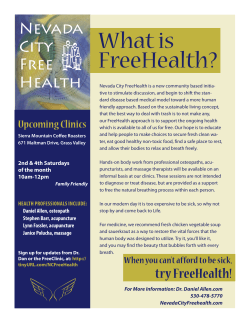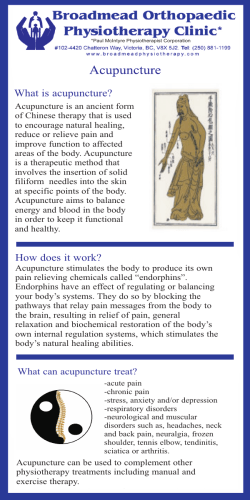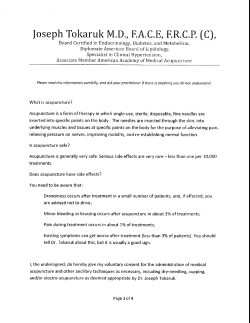
Dry Needling and Western Acupuncture Patient Information Sheet
Melbourne Health Policies, Procedures and Guidelines PATIENT BROCHURE: Dry Needling and Western Acupuncture Patient Information Sheet __________________________________________________________________________________________________________________ Category: Consumer, Carer and Community Participation Ref No.: AHPT02.01B __________________________________________________________________________________________________________________ Sub-Category: Consumer, Carer and Community Participation Version No.: 1 __________________________________________________________________________________________________________________ Dry Needling and Western Acupuncture Patient Information Sheet Issue Date: 29 Apr 2015 Expiry Date: 13 May 2018 __________________________________________________________________________________________________________________ Department: Allied Health aAcup Summary Points to Remember Dry Needling and/or Western Acupuncture is a form of treatment that can be offered as a part of your overall rehabilitation if indicated. Written consent needs to be gained from the patient prior to this treatment technique. What is Dry Needling? Dry needling involves inserting a very thin, sterile acupuncture style needle into the skin. The needle is inserted into abnormal or dysfunctional tissue, which may include: Muscle trigger points (taut bands of muscle commonly known as ‘knots’) Bone surface Other soft tissues such as tendons or ligaments Dry needling may only be used by physiotherapists who have completed an accredited dry needling course. It is a treatment technique available as part of your overall physiotherapy management plan. This will often include stretching and strengthening exercises following dry needling. What is the difference between Dry Needling and Western Acupuncture? Dry needling involves inserting a needle directly into the dysfunctional tissue for a very short period of time. Western Acupuncture, on the other hand, may include inserting needles into areas away from the source of pain and for a long period of time, up to 15 minutes. Western Acupuncture utilises ‘meridian’ points but applies it with ‘western’ reasoning, based on knowledge of neuro-anatomy. Is Dry Needling / Western Acupuncture the same as traditional acupuncture? No, although the needles and technique used in dry needling are similar, traditional acupuncture involves using meridian points based on a Traditional Chinese Medicine approach. The use of both dry needling and Western Acupuncture is based on the science of anatomy and biology combined with physiotherapy clinical reasoning. What are the benefits of dry needling / western acupuncture? Dry needling is used to help improve or restore function in affected tissues. It can help relax muscles and reduce pain. This should stimulate a healing response in the treated area and can reduce symptoms. When the needle is inserted into particular points of the body, it can stimulate different parts of the nervous system, including the brain, causing the release of chemicals and hormones, such as endorphins. These substances help to decrease pain, particular nerve-related pain. How does dry needling work? Dry needling to muscle trigger points can relax tight muscles. It is thought that because the presence of a needle in tense muscle may be painful, the nervous system sends signals to the muscle to relax. As muscle spasm is often the cause of pain or dysfunction, stopping or reducing this spasm can help relieve your symptoms to improve mobility and function. __________________________________________________________________________________________________________________ Authorised by: Director Allied Health Page 1 of 3 Document upload on 29 Apr 2015 Page 1 of 3 *NOTE - Printed or downloaded version are uncontrolled and subject to change* PATIENT BROCHURE: Dry Needling and Western Acupuncture Patient Information Sheet __________________________________________________________________________________________________________________ Category: Consumer, Carer and Community Participation Ref No.: AHPT02.01B __________________________________________________________________________________________________________________ Sub-Category: Consumer, Carer and Community Participation Version No.: 1 __________________________________________________________________________________________________________________ What are potential side effects? Issue Date: 29 Apr 2015 Expiry Date: 13 May 2018 __________________________________________________________________________________________________________________ Department: Allied Health Side effects can include muscle soreness during or after treatment, drowsiness, nausea, fainting, minor bruising or a short term worsening of symptoms. More serious complications are very rare. Your physiotherapist will discuss these with you before commencing treatment. What is involved? Before commencing: Your physiotherapist will discuss with you the benefits and potential risks of dry needling and/or Western Acupuncture and other treatment options available. Your physiotherapist will ask you safety questions and gain your consent for treatment. During treatment: The needle is very thin and you may not feel it penetrate your skin. When inserting the needle into tissues o You may initially feel a significant cramping or ‘twitch’ sensation in the tissue o Your pain may be reproduced Communication between you and your physiotherapist will allow safe application of the technique and reduce the risks of negative side effects. After needling: If excessive drowsiness occurs, you should avoid driving until recovered If bleeding occurs, compression should be applied to the treatment site with a dry cotton pad If treatment soreness or bruising occurs, using a cold/hot pack may help Any further questions? Discuss with your treating physiotherapist. Links and references: Guidelines for Safe Acupuncture and Dry Needling Practice. (2007). Australian Society of Acupuncture Physiotherapy Inc. Retrieved from http://www.combinedhealth.com.au Global Education of Manual Therapists. (2009). http://www.gemtinfo.com.au Royal Melbourne Hospital Physiotherapy Departmental Procedure – Dry Needling. (2012). Contact Practitioner / Patient notes Position title Department 9342 7440 Physiotherapy | AHPT02.01B| Manager Physiotherapy | April 2015 __________________________________________________________________________________________________________________ Authorised by: Director Allied Health Document upload on 29 Apr 2015 Page 2 of 3 Page 2 of 3 *NOTE - Printed or downloaded version are uncontrolled and subject to change* PATIENT BROCHURE: Dry Needling and Western Acupuncture Patient Information Sheet __________________________________________________________________________________________________________________ Category: Consumer, Carer and Community Participation Ref No.: AHPT02.01B __________________________________________________________________________________________________________________ Sub-Category: Consumer, Carer and Community Participation Version No.: 1 __________________________________________________________________________________________________________________ Issue Date: 29 Apr 2015 Expiry Date: 13 May 2018 __________________________________________________________________________________________________________________ Department: Allied Health __________________________________________________________________________________________________________________ Authorised by: Director Allied Health Document upload on 29 Apr 2015 Page 3 of 3 Page 3 of 3 *NOTE - Printed or downloaded version are uncontrolled and subject to change*
© Copyright 2025










